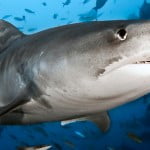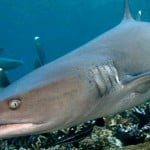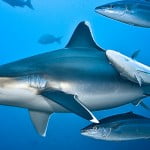
Copyright © 2012, Fiji Times Limited. All Rights Reserved.
Shark census
Ilaitia Turagabeci (Wednesday, April 04, 2012)
THE seas around our 300-plus islands are abuzz with anticipation for the Great Fiji Shark Count.
From tourism operators, adventurers, marine researchers, coastal fishermen, deep sea anglers, anyone with a love for the blue and the wonders living in it, it’s a time to check who is alive down there, and how many.
The great invite across the isles and abroad is a scientific research which aims to put a population figure to the different species of sharks, rays and turtles in our waters.
The Great Fiji Shark Count an initiative of Fiji tourism operators and organised by Helen Sykes, the co-ordinator of Fiji Coral Reef Monitoring Network will be held throughout this month and November.
“It’ll involve everyone and is very exciting,” she said.
“We’ll count the sharks, rays and turtles during diving, snorkelling, fishing trips or on boat voyages and contribute to shark research and protection.”
The event follows on the heels of another of her work the Great Fiji Butterflyfish Count in 2008-2009.

Endangered ... whale sharks - a rare sighting in Fiji will be noted in this month's The Great Fiji Shark Count. Picture: BRIAN SKERRY
Scott Kukral, in his Fiji Sea Travel newsletter, said the survey would “yield some surprising results”.
“Whether you are a local or a visitor to Fiji, a professional or amateur, or just would like to contribute to the study and protection of marine life, The Great Fiji Shark Count is your chance to make a difference,” he said.
“Following the recent trend for scientific study to incorporate the observation and input of virtually every interested party (also referred to as citizen science), this study will channel the input of hundreds of volunteers over a specified study period, accumulating observational data that would otherwise be impossible for a team of scientists.
“This method has proven highly successful in fields from astronomy (Galaxy Zoo) to ornithology (organised bird counts), with the Great Fiji Butterflyfish Count being another great example.”
Ms Sykes said scientists could not do the job alone.
“… we can never get this amount of information from scientists working alone, and we are expecting to get some really eye-opening data,” she said.
“It also gives the participating operators and their guests a chance to do something positive for the reef life that supports their business, and to contribute the knowledge that they gather every day.”
Data collected this month and in November will be used to better understand the patterns of the marine ecosystem’s health and monitor the effectiveness of shark protection measures as well as develop new strategies.
She said survey results would be made available to everyone striving to establish and promote our ocean’s health.
Mamanuca Environment Society assistant project manager Diane Tora said knowing the types of shark species in the Mamanuca waters and their numbers would help them spread awareness to the communities and guests
“… at the same time considering the fact that sharks outlived the dinosaurs to becoming the apex predators, we will be joining our members who have registered to this event on their trips out, and we really hope to get our local communities involved as well,” she said.
“Some of our resorts, I believe, would really just want to know the types of sharks that visit their shores as interesting information for their guests and also in support of protecting Fiji sharks. Getting everyone local communities, tourism operators, and dive operators to participate will create awareness on the sharks’ importance. Sharks have a purpose.”
Ms Sykes said survey participants would fill forms before they go to sea and log all identification of species they see when they return.
Rays are being counted in this survey because they are closely related to sharks, sharing the same plight of overfishing, and turtles because they are an endangered species and mostly located to where sharks are, off the reef out in deep water.
Mr Kukral said while all of Fiji would be fair game for the count, the Fiji shark corridor in the Beqa Lagoon region “is likely to be one of most profilic areas”.
“Home of the world renowned shark dives in the Shark Reef Marine Reserve, it is not unheard of to encounter up to eight different species of shark on a single dive,” he said. “The main reason (for the count) is to get a baseline count of sharks, rays and turtles to better understand their populations, and then to compare future counts to help establish the effectiveness of conservation efforts.”
The concept of the study, he added, would allow a wider participation and more abundant data collection.
“This dovetails with the tourism industry, as many tourists look for causes to contribute to and feel like their holiday serves a dual purpose. This all offers tourists an additional reason to come to Fiji and enhances their vacation experience.
“My goal is to make my clients aware of the possibilities, contribute to the awareness of shark conservation and spread the word that sharks are a valuable asset certainly more so alive (tourism income and the overall health of the marine ecosystem) than dead … All around, very much a win-win situation.”
The campaign is supported by the Ministry of Fisheries and Forests, eshark (www.eshark.org), Marine Ecology Consulting, Ocean Soaps (www.oceansoaps.com.fj), Save Our Seas Foundation, Shark Foundation (www.shark.ch), Shark Reef Marine Reserve and Shark Savers.
* For more information on
The Great Fiji Shark Count, go to
www.fijisharkcount.com
Copyright © 2012, Fiji Times Limited. All Rights Reserved.














